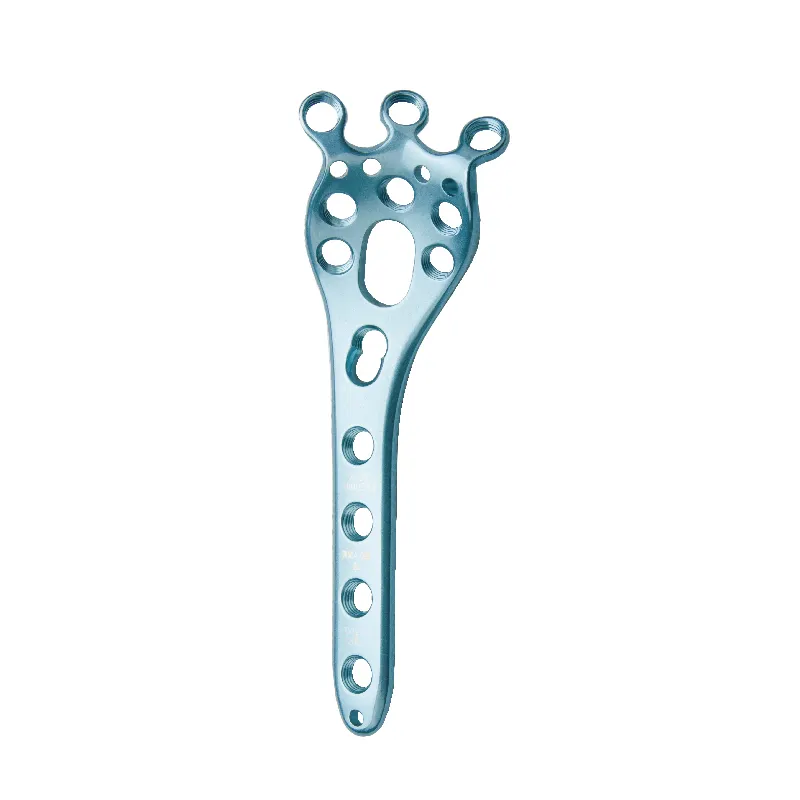Enhancing Stability in Fracture Fixation with Modern Locking Plates
Fracture fixation is a critical step in orthopedic treatment that determines the speed and quality of bone healing. Among various fixation devices, locking plates have emerged as a pivotal innovation, offering enhanced stability and support for complex fractures. Their mechanical design and material properties address many challenges faced by traditional fixation methods, providing reliable outcomes in fracture management.
This article discusses how locking plates contribute to improved fracture fixation stability. It highlights the mechanical principles behind their success, clinical benefits, and their application across different fracture types. Understanding the role of locking plates helps surgeons and patients appreciate the advancements in orthopedic care.
Mechanical Principles of Locking Plates
Fixed-Angle Stability
Locking plates distinguish themselves from traditional plates through the use of screws that lock directly into the plate, forming a fixed-angle construct. This innovative design effectively prevents the screws from loosening over time and offers enhanced angular stability. Such stability is particularly advantageous when treating fractures involving poor bone quality or complex anatomical shapes, as it ensures a more secure fixation and reduces the risk of mechanical failure during the healing process.
The fixed-angle stability provided by locking plates enables the entire construct to function as a cohesive unit, ensuring that mechanical loads are distributed more evenly across the fracture site. This even distribution significantly reduces micromotion, which is essential for fostering effective bone healing. By minimizing movement at the fracture site, the risk of complications caused by instability is also greatly decreased, leading to improved outcomes in fracture management.
Load Distribution and Stress Shielding
Locking plates are designed to distribute load in a way that significantly enhances their performance in fracture treatment. Unlike traditional plates that press tightly against the bone surface, locking plates maintain a slight gap between the plate and the bone. This design preserves the bone’s natural blood supply, which is crucial for healing, and helps to reduce stress shielding—a phenomenon where the bone is deprived of normal mechanical stress, potentially leading to weakening. By allowing the bone to bear some of the load naturally, locking plates promote healthier bone remodeling and better overall recovery.
By distributing the load evenly among the plate, screws, and the bone itself, locking plates establish a balanced mechanical environment that is essential for effective fracture healing. This balanced load sharing helps to prevent bone resorption, which can occur when the bone is either overstressed or underutilized. Additionally, it reduces the risk of implant failure by minimizing excessive stress concentrations on any single component. This harmonious interaction between the implant and the bone supports long-term stability and promotes a successful recovery process.
Clinical Benefits of Locking Plates
Improved Stability in Osteoporotic Bone
Osteoporotic bone poses considerable challenges for fracture fixation because of its diminished density and mechanical strength. In such cases, locking plates offer distinct advantages since their fixed-angle screws can achieve a secure hold even within the fragile bone structure. This secure fixation is critical for maintaining stability, as traditional fixation methods may fail to anchor properly in osteoporotic bone. By providing reliable screw purchase, locking plates help ensure the fracture site remains stable throughout the healing process, reducing the risk of complications and improving overall outcomes.
This improved stability significantly lowers the chances of implant loosening or failure, factors that can jeopardize the healing of fractures. For patients suffering from osteoporosis, locking plates provide a more dependable fixation method, allowing for earlier movement and activity. Consequently, this leads to improved functional recovery and a smoother rehabilitation process, which are essential for maintaining quality of life in individuals with weakened bone structures.
Versatility in Complex Fracture Patterns
Locking plates offer exceptional versatility, making them suitable for various fracture types, including comminuted and multi-fragmentary fractures. Their unique design enables effective stabilization of multiple bone fragments while maintaining the integrity of the surrounding blood supply. This preservation of vascularization is crucial for promoting natural bone healing and reducing the risk of complications. As a result, locking plates are particularly well-suited for managing complex fractures where both stability and biological factors must be carefully balanced to ensure optimal recovery.
Surgeons have the ability to customize locking plate constructs to meet the specific requirements of each fracture, allowing for tailored fixation approaches that maximize stability. This adaptability broadens the range of fractures that can be successfully managed with internal fixation techniques. By adjusting the placement and configuration of locking plates and screws, surgeons can address the unique anatomical and mechanical challenges presented by different fracture patterns, ultimately improving patient outcomes and promoting effective healing.

Surgical Application and Techniques
Minimally Invasive Approaches
The design of locking plates supports minimally invasive surgical techniques, which have become increasingly popular due to their benefits in reducing soft tissue damage and postoperative pain. Locking plates can be inserted through smaller incisions, preserving the biological environment around the fracture.
Minimally invasive application also shortens surgical time and reduces infection risk. These factors contribute to improved patient recovery and satisfaction.
Customized Fixation Strategies
Locking plates come in various shapes and sizes, allowing customization to patient anatomy and fracture configuration. Surgeons select appropriate plates and screws to achieve optimal fixation tailored to the specific clinical situation.
The ability to customize fixation helps address challenges posed by difficult fractures and patient variability, improving the overall success rate of fracture management.
Innovations and Future Directions
Advanced Materials and Coatings
Recent advancements in locking plates include the development of new materials and surface coatings that enhance biocompatibility and reduce infection risk. Innovations such as titanium alloy plates with antibacterial coatings are designed to improve patient outcomes.
These enhancements aim to further increase the durability and safety of locking plates, making them even more effective in diverse clinical scenarios.
Integration with Digital Planning Tools
Digital technologies like 3D imaging and surgical navigation are increasingly integrated with locking plate fixation. These tools allow precise preoperative planning and intraoperative guidance, ensuring accurate implant placement and alignment.
The integration of digital tools optimizes the use of locking plates, reducing complications and improving healing outcomes.
Frequently Asked Questions
What makes locking plates more stable than traditional plates?
Locking plates provide fixed-angle stability by locking screws into the plate, creating a rigid construct that resists loosening and distributes mechanical loads more effectively.
Are locking plates suitable for all types of fractures?
Locking plates are versatile and can be used for many fracture types, especially complex and osteoporotic fractures, but the choice depends on individual fracture characteristics and surgeon assessment.
How do locking plates benefit patients with osteoporosis?
Locking plates secure screws firmly in weak bone, reducing implant loosening and improving fixation stability, which supports better healing in osteoporotic patients.
What surgical techniques are used with locking plates?
Locking plates support minimally invasive approaches, allowing smaller incisions and less soft tissue damage, which contribute to faster recovery and fewer complications.
 EN
EN
 FR
FR
 ES
ES
 AR
AR

